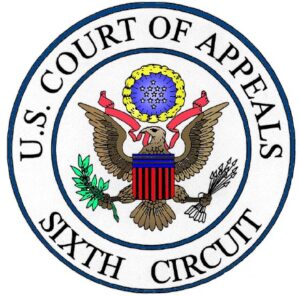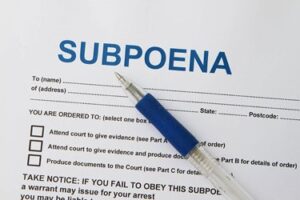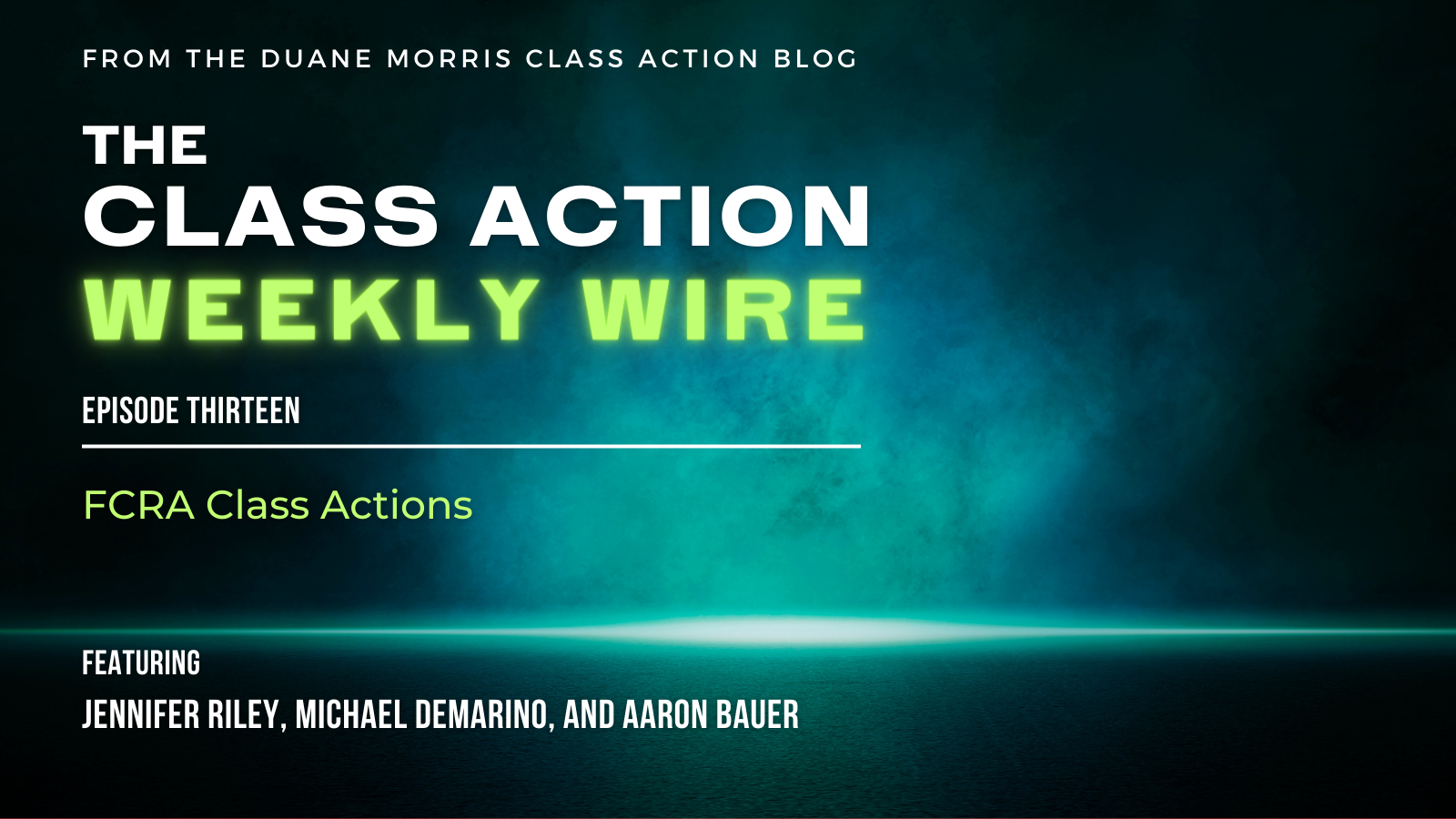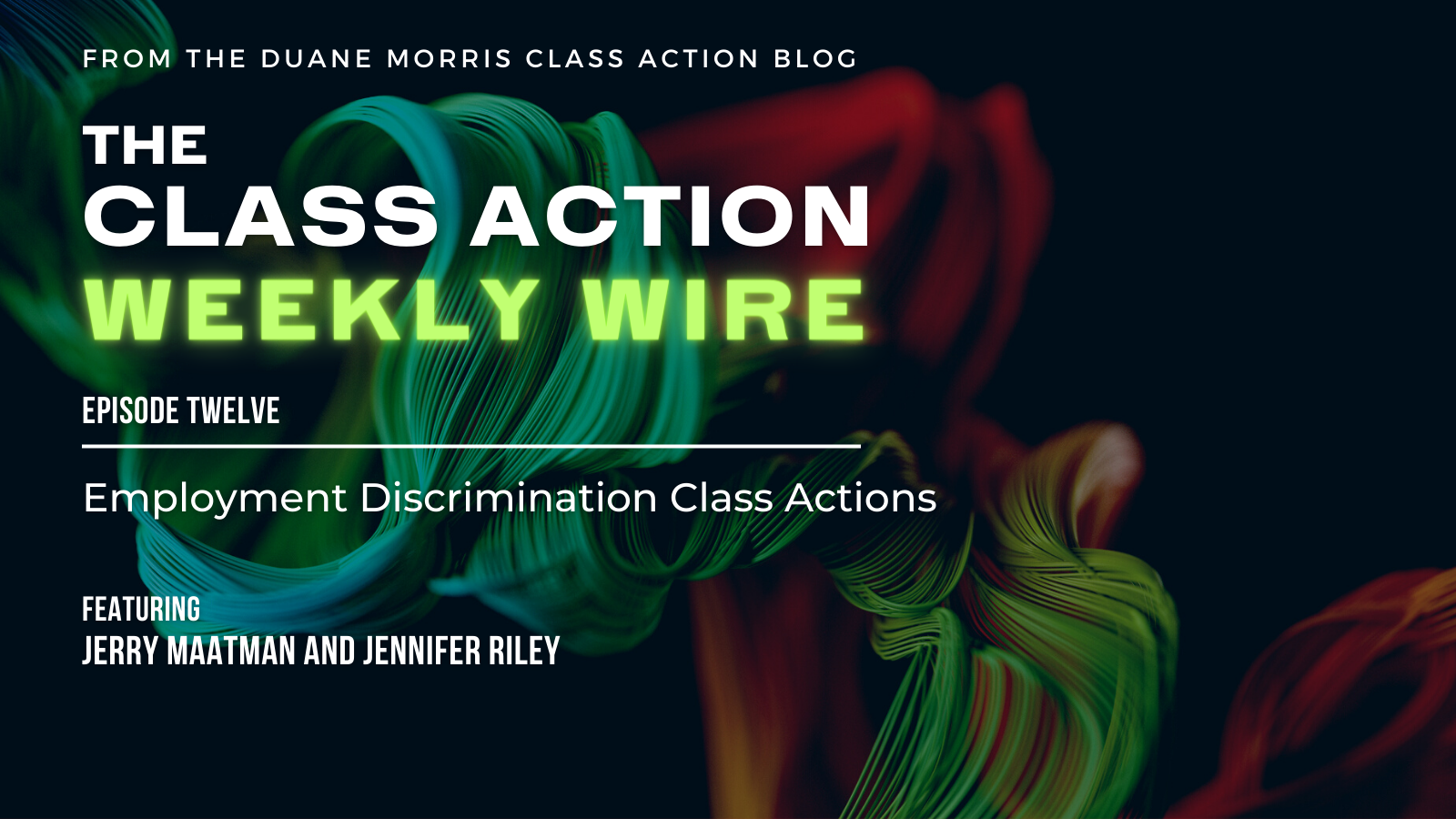New Jersey Determines That Class Action Waiver Untethered To An Arbitration Agreement Is Unenforceable
 By Eden Anderson and Rebecca Bjork
By Eden Anderson and Rebecca Bjork
Duane Morris Takeaway: In Pace, et al. v. Hamilton Cove, Case No. A-0674-22 (N.J. Super. Ct. App. Div. May 18, 2023), the New Jersey Superior Court, Appellate Division, found a class action waiver unenforceable without an explicit arbitration clause in a lease agreement. The ruling should be a required read for businesses trying to implement an enforceable class action waiver, as it demonstrates why it is necessary to include such a provision in a contract that includes an arbitration clause.
Case Background
Two tenants of a residential apartment complex filed a putative class action against their landlord alleging claims of common law fraud and for violation of New Jersey’s Consumer Fraud Act (CFA). The tenants alleged that the landlord made false promises concerning the amount of security that would be provided at the complex, which was located in a high crime area. The advertisements for the complex promised that it would have “elevated, 24/7 security.” Id. at 3. Specifically, during a tour of the apartment complex, the plaintiffs were assured that there would be in person security stationed near building entrances day and night.
The plaintiffs contended that despite the promises made by the defendants, the sole security was a front desk greeter who were present only during regular business hours and was often not stationed at the desk at all. The plaintiffs asserted that they relied upon the representations made by the defendant when selecting and moving into the apartment complex, that defendants engaged in an unconscionable business practice in violation of the CFA, and that tenants overpaid for the apartments because they did not receive the full value promised, constituting an ascertainable loss. Id. The tenants’ lease included a class action waiver, but no mandatory arbitration clause.
The defendants filed a motion to dismiss for failure to state a claim, or in the alternative, to strike the class allegations. The defendants stated that the leases were not contracts of adhesion and that the class action waivers included in the lease agreements were valid and enforceable. The plaintiffs argued the leases were contracts of adhesion, the class action waivers were unconscionable, and the case law supporting the enforceability of class action waivers was inapplicable to this case.
The trial court denied the defendants’ motion. On the defendants’ appeal, the New Jersey Appellate Division affirmed the trial court’s ruling.
The Court’s Ruling
The Appellate Division acknowledged state and federal precedent upholding the enforceability of class action waivers in arbitration agreements, including the U.S. Supreme Court’s decision in AT&T Mobility LLC v. Concepcion, 563 U.S. 333 (2011). The Appellate Division stated that an arbitration agreement necessarily involves a waiver of a party’s right to have claims litigated in court, and here, in contrast, there was no agreement to arbitrate contractual disputes. The Appellate Division held, however, that the policies favoring arbitration and encouraging enforcement of arbitration agreements, as expressed in the Federal Arbitration Act and the New Jersey Arbitration Act, are irrelevant when an arbitration agreement is not at issue.
Instead, the Appellate Division determined that New Jersey’s policy favoring class actions applied, and that “there is no societal interest in enforcing a class action waiver in a contract that does not contain a mandatory arbitration provision.” Id. at 15. Accordingly, the Appellate Division determined that the plaintiffs were not bound to arbitration and were free to litigate their claims in court.
Implications Of The Decision
Any business trying to implement an enforceable class action waiver should include such a provision in a contract that includes an arbitration clause. Had the landlord here included an arbitration clause in its lease, the outcome of the case may have been very different and class litigation avoided.
A Stellar Review For The Duane Morris Class Action Review – 2023
 By Gerald L. Maatman, Jr. and Jennifer A. Riley
By Gerald L. Maatman, Jr. and Jennifer A. Riley
Duane Morris Takeaway: In its review of the Duane Morris Class Action Review – 2023, EPLiC Magazine called it the “the Bible” on class action litigation and an essential desk reference for business executives, corporate counsel, and human resources professionals.
We are humbled and honored by the recent review of the first edition of the Duane Morris Class Action Review – 2023 by Employment Practices Liability Consultant Magazine (“EPLiC”) – the review is here.
EPLiC said that “The Review must-have resource for in-depth analysis of class actions in general and workplace litigation in particular.”
EPLiC continued that “The Duane Morris Class Action Review analyzes class action trends, decisions, and settlements in all areas impacting Corporate America. The Review also highlights key rulings on attorneys’ fee awards in class actions, motions granting and denying sanctions in class actions, and the top class action settlement in a myriad of substantive areas. Finally, the Review provides insight as to what companies and corporate counsel can expect to see in 2023 in terms of filings by the plaintiffs’ class action bar.”
So how was it done?
The answer is pretty simple – we live, eat, and breathe class action law 24/7/365.
Every day, morning and evening, we check the previous day’s filings of class action rulings relative to antitrust class actions, appeals in class actions, arbitration issues in class actions, Class Action Fairness Act issues in class actions, civil rights class actions, consumer fraud class actions, data breach class actions, EEOC-initiated litigation, employment discrimination class actions, Employee Retirement Income Security Act class actions, Fair Credit Reporting Act class actions, wage & hour class actions, labor class actions, privacy class actions, procedural issues in class actions, product liability & mass tort class actions, Racketeer Influenced and Corrupt Organization Act class actions, securities fraud class actions, settlement issues in class actions, state court class actions, Telephone Consumer Protection Act class actions, and Worker Adjustment and Retraining Act class actions. We conduct searches on a national basis, in federal courts and all 50 states. Then we read and analyze every ruling on Rule 23 certification motions and subsidiary issues throughout federal and state trial and appellate courts. The information is organized in our customized database, which is used to provide the Review’s one-of-a-kind analysis and commentary.
The result is a compendium of class action law unlike any other. Thanks for the kudos EPLiC – we sincerely appreciate it!
We look forward to providing the 2024 Review to all of our loyal readers in early January. In the meantime, look for our first-ever Mid-Year Update coming at the beginning of July!
Sixth Circuit Adopts Heightened Standard For Certification Of FLSA Collective Actions
 By Gerald L. Maatman, Jr., Jennifer A. Riley and Kathryn R. Brown
By Gerald L. Maatman, Jr., Jennifer A. Riley and Kathryn R. Brown
Duane Morris Takeaways: In Clark v. A&L Homecare and Training Center, LLC, Nos. 22-3101, 3102 & 2023 WL 3559657 (6th Cir. May 19, 2023) a split three judge-panel for the U.S. Court of Appeals for the Sixth Circuit held that in actions brought under the Fair Labor Standards Act (FLSA), plaintiffs must show a “strong likelihood” of being “similarly situated” to other individuals allegedly subject to the same violations of the statute in order to secure certification of a collective action. The ruling should be a required read for companies involved in wage & hour litigation.
The new approach announced by the Sixth Circuit disrupts the plaintiff-friendly framework courts have applied for years to conditionally certify FLSA collective actions based on minimal evidence. As the majority of the panel recognized, a court’s decision to issue notice in an FLSA collective action has the potential to expand the scope and cost of discovery to such a degree that defendants are compelled to settle, regardless of the merits of the claims at issue. The “strong likelihood” standard gives district courts greater authority to test a plaintiff’s assertions of similarity before approving notice in an FLSA collective action. As such, the ruling has major consequences for litigants in the Sixth Circuit, which covers Ohio, Kentucky, Tennessee and Michigan.
Case Background
The named plaintiffs brought a putative collective action under the FLSA against their former employer and its owners, challenging pay practices they alleged ran afoul of the FLSA’s overtime and minimum wage requirements. The named plaintiffs filed a motion with the district court seeking conditional certification of three collective actions of employees alleged to have been subject to the same pay practices. In an August 4, 2021 opinion, the district court granted plaintiffs’ motion as to two of the three proposed collective actions. Holder v. A&L Home Care & Training Ctr., LLC, 552 F. Supp. 3d 731, 740 (S.D. Ohio 2021). In conditionally certifying two collective actions, the district court applied the oft-used two-step framework set forth in Lusardi v. Xerox Corp., 118 F.R.D. 351 (D.N.J. 1987).
Under the Lusardi framework, named plaintiffs need only present what courts have described as a “modest factual showing” that similar potential plaintiffs exist to satisfy the first step, i.e., certification of a collective action on a conditional basis. In the second step, assuming others have joined the lawsuit as opt-in plaintiffs and the parties have completed discovery on the merits, the district court makes a final determination whether the opt-in plaintiffs actually qualify as parties to the litigation on the basis of substantial similarity to the named plaintiffs in what is known as a second-stage final certification order.
The district court acknowledged that the Fifth Circuit in Swales v. KLLM Transport Services, L.L.C., 985 F.3d 430, 443 (5th Cir. 2021), had rejected the Lusardi approach in favor of “rigorous” enforcement of the similarity requirement in a single step, after a period of preliminary discovery. The Sixth Circuit declined to follow suit. Recognizing district courts’ need for guidance on the standard for sanctioning notice to putative opt-in plaintiffs in FLSA cases, however, the district court certified its decision for immediate interlocutory review by the Sixth Circuit under 28 U.S.C. § 1292(b). The Sixth Circuit accepted the appeal in order to address, for the first time, the legal issue of what a plaintiff needs to show in order to convince a court to allow notice to others of their ability to join the plaintiff’s FLSA lawsuit.
The Sixth Circuit’s Decision
The two-judge majority of the Sixth Circuit panel rejected both the Lusardi approach and the Swales approach. Judges Kethledge and Bush endorsed a “strong likelihood” standard as the new framework to guide courts in the Sixth Circuit. In an opinion concurring in part and dissenting in part, Judge White denounced the single-step approach in Swales and criticized the Lusardi approach as flawed, but found it unnecessary to adopt a new standard.
The majority opinion suggests that the new standard involves two steps. Writing for the two-judge majority, Judge Kethledge analogized the showing of similarity required under the new standard to what a movant must show to secure a preliminary injunction, i.e., that, to a certain degree of probability, the movant will prevail on the underlying issue when the court makes its final decision whether to enjoin or not. Judge Kethledge’s opinion focuses on the first step, which requires a named plaintiff to show it is strongly likely that members of the putative collective action are “in fact similarly situated” to the named plaintiff, without stating the contours of the second step. The opinion cautions district courts to “expedite” ruling on motions for such notice in FLSA cases in light of the general two-year statute of limitations period for FLSA claims. See 29 U.S.C. § 255(a).
Importantly, as to what district courts should consider in applying the new standard, the three judges on the Sixth Circuit panel found common ground. The panel agreed that district courts should consider the impact of the different defenses to which potential members of the collective action may be subject in making the notice determination. For example, whether some potential plaintiffs signed arbitration agreements and whether the statute of limitations would bar some potential plaintiffs’ claims are fair game in a district court’s decision whether to allow notice.
The two-judge majority of the panel vacated the district court’s August 2021 order and remanded for the district court to apply the new standard of “strong likelihood” of similarity to the named plaintiffs’ motion to notify members of the putative collectives.
Implications For Employers
The A&L Homecare decision is consequential because it ushers in a new, more defense-friendly threshold for sanctioning notice of a putative FLSA collective action lawsuit. Plaintiffs litigating FLSA cases in the Sixth Circuit face a heavier burden to show they are similarly situated to the individuals they seek to notify of the lawsuit. The ruling is also significant because it confirms that district courts should account for defenses that potentially differentiate the named plaintiffs from the putative opt-in plaintiffs in deciding whether the named plaintiffs have satisfied their burden to issue notice.
In A&L Homecare, the Sixth Circuit becomes the latest federal appellate court to abandon the long-used two-step approach set forth in Lusardi. Just a month ago, in Matthews v. USA Today Sports Media Group, LLC, et al., No. 1:22-CV-1307 (E.D. Va.), a district court in the Fourth Circuit followed the Fifth Circuit’s approach in Swales, as we previously reported.
The absence of a unified approach among federal courts to the question of notice in collective actions derives in part from the FLSA statute itself. The statute contemplates that “similarly situated” others may join a lawsuit asserting claims under the FLSA, but says nothing about the process by which they may do so. See 29 U.S.C. § 216(b).
It remains to be seen whether other federal courts will abandon the plaintiff-friendly approach of Lusardi in favor of the one-step standard in Swales, the “strong likelihood” standard in A&L Homecare, or yet another standard. Given the disparate approaches of federal district and appellate courts, the legal question of a plaintiff’s showing of similarity to members of a putative collective action may well land on the Supreme Court’s docket.
EEOC Issues New Resource On Artificial Intelligence Use In Employment Decisions
 By Alex W. Karasik and Gerald L. Maatman, Jr.
By Alex W. Karasik and Gerald L. Maatman, Jr.
Duane Morris Takeaways: On May 18, 2023, the EEOC released a technical assistance document, “Assessing Adverse Impact in Software, Algorithms, and Artificial Intelligence Used in Employment Selection Procedures Under Title VII of the Civil Rights Act of 1964,” (hereinafter, the “Resource”) to provide employers guidance on preventing discrimination when utilizing artificial intelligence. For employers who are contemplating whether to use artificial intelligence in employment matters such as selecting new employees, monitoring performance, and determining pay or promotions, this report is a “must-read” in terms of implementing safeguards to comply with civil rights laws.
Background
As the EEOC is well-aware, employers now have a wide variety of algorithmic decision-making tools available to assist them in making employment decisions, including recruitment, hiring, retention, promotion, transfer, performance monitoring, demotion, dismissal, and referral. Employers increasingly utilize these tools in an attempt to save time and effort, increase objectivity, optimize employee performance, or decrease bias. The EEOC’s Resource seeks to inform employers how to monitor the newer algorithmic decision-making tools and ensure compliance with Title VII.
To set the parameters for the Resource, the EEOC first defines a few key terms:
- Software: Broadly, “software” refers to information technology programs or procedures that provide instructions to a computer on how to perform a given task or function.
- Algorithm: Generally, an “algorithm” is a set of instructions that can be followed by a computer to accomplish some end.
- Artificial Intelligence: In the employment context, using AI has typically meant that the developer relies partly on the computer’s own analysis of data to determine which criteria to use when making decisions. AI may include machine learning, computer vision, natural language processing and understanding, intelligent decision support systems, and autonomous systems.
Taken together, employers sometimes utilize different types of software that incorporate algorithmic decision-making at a number of stages of the employment process. Some of the examples provided by the EEOC in terms of how employers can utilize artificial intelligence include: resume scanners that prioritize applications using certain keywords; employee monitoring software that rates employees on the basis of their keystrokes; “virtual assistants” or “chatbots” that ask job candidates about their qualifications and reject candidates who do not meet pre-defined requirements; video interviewing software that evaluates candidates based on their speech patterns and facial expressions; and testing software that provides “job fit” scores for applicants or employees regarding their personalities, aptitudes, cognitive skills, or perceived “cultural fit,” which is typically based on their performance on a game or on a more traditional test.
“Questions And Answers” About AI
After summarizing the pertinent provisions of Title VII, the heart of the EEOC’s Resource is presented in a question and answer format. First, the EEOC defines a “selection procedure” to be any “measure, combination of measures, or procedure” if it is used as a basis for an employment decision. Employers can assess whether a selection procedure has an adverse impact on a particular protected group by checking whether use of the procedure causes a selection rate for individuals in the group that is “substantially” less than the selection rate for individuals in another group. If there is an adverse impact, then use of the tool will run afoul of Title VII unless the employer can demonstrate that, pursuant to Title VII, such use is “job related and consistent with business necessity.”
The EEOC then posits the critical question of whether an employer is responsible under Title VII for its use of algorithmic decision-making tools even if the tools are designed or administered by another entity, such as a software vendor. This is an important issue since many companies seek the assistance of third-party technologies to facilitate some of their employment-decision processes. The EEOC indicates that “in many cases, yes,” employers are responsible for the actions of their agents, such as third-party vendors. Ultimately, if the employer is making the final employment decision, the buck would likely stop with the employer in terms of Title VII liability .
The EEOC also defines the term, “selection rate,” which refers to the proportion of applicants or candidates who are hired, promoted, or otherwise selected. The selection rate for a group of applicants or candidates is calculated by dividing the number of persons hired, promoted, or otherwise selected from the group by the total number of candidates in that group. By virtue of including this definition in the Resource, a reading of the tea leaves suggests that the EEOC will be monitoring selection rates to determine whether there is an adverse impact in employment decisions that were catalyze from the use of artificial intelligence.
In terms of what is an acceptable selection rate, the EEOC relies on the “four-fifths rule,” which is a general rule of thumb for determining whether the selection rate for one group is “substantially” different than the selection rate of another group. The rule states that one rate is substantially different than another if their ratio is less than four-fifths (or 80%). For example, if the selection rate for Black applicants was 30% and the selection rate for White applicants was 60%, the ratio of the two rates is thus 30/60 (or 50%). Because 30/60 (or 50%) is lower than 4/5 (or 80%), the four-fifths rule dictates that the selection rate for Black applicants is substantially different than the selection rate for White applicants, which may be evidence of discrimination against Black applicants.
The EEOC does note that the, “four-fifths rule” is a general suggestion, and may not be appropriate in every circumstance. Some courts have also found this rule to be inapplicable. Nonetheless, employers would be prudent to ask whether artificial intelligence vendors deployed the “four-fifths rule” in their algorithms. Statistics matter here.
Finally, the EEOC posits the issue of what an employers should do when they discover that the use of an algorithmic decision-making tool would result in an adverse impact. The EEOC explains that one advantage of algorithmic decision-making tools is that the process of developing the tool may itself produce a variety of comparably effective alternative algorithms. Accordingly, employers’ failure to adopt a less discriminatory algorithm that may have been considered during the development process could give rise to liability. Employers should thus take heed to document the steps they take to utilize non-discriminatory algorithms.
Implications For Employers
The use of artificial intelligence in employment decisions may be the new frontier for future EEOC investigations. While these technologies can have tremendous cost-benefits, the risk is undeniable. Inevitably, some employer using AI will be the subject of a test case in the future.
Employers should monitor the results of their own use of artificial intelligence. This can be accomplished by conducting self-analyses on an ongoing basis, to determine whether employment practices are disproportionately having a negative impact on certain protected classes.
As the EEOC notes, employers can proactively change the practices going forward. Given the agility of the artificial intelligence software, employers who do find the technologies’ “employment decisions” to be problematic can and should work with vendors to remedy such defects.
We encourage our loyal blog readers to stay tuned as we continue to report on this exciting and rapidly evolving area of law.
The Class Action Weekly Wire – Episode Thirteen
Duane Morris Takeaway: This week’s episode of the Class Action Weekly Wire features Duane Morris partners Jennifer Riley and Mike DeMarino and associate Aaron Bauer with their analysis of the Fair Credit Reporting Act class action litigation trends and developments in 2022 and what to expect in 2023. We hope you enjoy it.
Eleventh Circuit Issues Landmark Ruling That Limits The EEOC’s Subpoena Powers
 By Gerald L. Maatman, Jr., Alex W. Karasik, and Nicolette J. Zulli
By Gerald L. Maatman, Jr., Alex W. Karasik, and Nicolette J. Zulli
Duane Morris Takeaways: In EEOC v. Eberspaecher North America Inc. , No. 21-13799, 2023 U.S. App. LEXIS 11466 (11th Cir. May 10, 2023), a split three judge-panel for the U.S. Court of Appeals for the Eleventh Circuit affirmed an Alabama federal district court’s ruling and held that that an EEOC subpoena for nationwide information relative to an investigation over potential disability discrimination was too broad in scope.
Given that the EEOC’s pre-suit subpoena power is rarely limited by courts, this ruling is vitally important and apt to be cited by employers who are confronted with far-reaching EEOC subpoenas, particularly for nationwide employee data.
Case Background
A former employee at Eberspaecher North America Inc.’s (“ENA”) Northport, Alabama facility filed a charge with the EEOC, alleging ADA violations due to disability-related absences and his subsequent termination. Id. at *4. The initial charge listed only the Northport facility’s address and alleged discriminatory practices related to qualified leave. The charge did not advance any nationwide allegations.
In response, the EEOC requested information exclusively pertaining to the charged conduct from ENA’s Northport facility. However, the EEOC later requested nationwide nationwide data on employees terminated for attendance infractions at all of ENA’s locations. ENA declined to provide this information, leading the EEOC to issue a subpoena demanding the nationwide data.
On June 30, 2021, the EEOC filed an application for judicial enforcement of the subpoena with the U.S. District Court for the Northern District of Alabama. ENA moved to revoke the subpoena, arguing that it exceeded the scope of the charge. The District Court ruled in favor of ENA, ordering compliance with the subpoena limited to the Northport facility. The EEOC appealed the decision. Id. at *9.
The Eleventh Circuit’s Decision
The Eleventh Circuit affirmed the District Court’s order that ENA comply with the subpoena, “but only as it applies to [ENA’s] Northport facility.” Id. at *8.
On appeal, the EEOC attempted to argue that (1) because the charge was based on a review of ENA’s company-wide handbook; and (2) because the use of the term “aggrieved employees” in the charge meant “all employees” impacted by ENA’s allegedly unlawful practices, it was entitled to nationwide data. Id. at *16.
The Eleventh Circuit rejected these arguments because it presupposed that the charge targeted ENA facilities worldwide. Specifically, the Eleventh Circuit concluded that the charge, which solely referenced ENA’s Northport facility, constrained the EEOC’s subpoena power. It emphasized that the relevance of the requested information should be tied to the charge against the employer and not future charges. Additionally, the Eleventh Circuit noted that the EEOC never attempted to amend the charge to expand its scope. Id.
Rejecting the EEOC’s broad request for information, the Eleventh Circuit explained that “[t]he relevance that is necessary to support a subpoena for the investigation of an individual charge is relevance to the contested issues that must be decided to resolve that charge, not relevance to issues that may be contested when and if future charges are brought by others.” Id. at *5 (citing EEOC v. Royal Caribbean Cruise, Ltd., 771 F.3d 757, 761 (11th Cir. 2014)). The Eleventh Circuit further explained that the charge did not provide notice of an investigation into ENA’s facilities nationwide. Accordingly, the Eleventh Circuit held that the District Court did not abuse its discretion by enforcing the EEOC’s subpoena of information only as to the Northport facility.
Implications For Employers
The Eberspaecher decision is noteworthy because court rulings that restrict the EEOC’s pre-suit enforcement actions are uncommon, particularly at the appellate level. This decision provides a roadmap for employers to challenge subpoenas or requests for information that exceed the charge’s scope.
While this decision represents a significant blow to the EEOC’s common practice of seeking company-wide data in administrative subpoenas, employers should note that the EEOC may seek to amend charges to include systemic allegations before serving future subpoenas. Accordingly, while this ruling is a rare management-side victory in EEOC subpoena enforcement actions, it remains to be seen whether future charges will be pleaded with an eye towards nationwide discovery in light of this new roadblock.
Seventh Circuit Affirms That ERISA Plan Sponsors Do Not Act As Participants’ Fiduciaries And Must Follow The Terms Of The Plan As Written
 By Gerald L. Maatman, Jr. and Jeffrey R. Zohn
By Gerald L. Maatman, Jr. and Jeffrey R. Zohn
Duane Morris Takeaways: More than 10 years after Plaintiffs filed suit in Carlson et al. v. Northrop Grumman Severance Plan et al., No. 22-1764, 2023 WL 3299703 (7th Cir. May 8, 2023), the Seventh Circuit put to rest the idea that a sponsor of an ERISA welfare-benefit plan is a fiduciary of the plan’s participants. Instead, per the ruling in Carlson, the sponsor is obligated to follow the terms of the plan as written. When the plan grants the sponsor discretion to determine who qualifies, the sponsor may exercise that discretion and may even change the way it exercises that discretion over time. If the plan does not grant the sponsor any such discretion, the sponsor must abide by the precise terms of the plan. The Seventh Circuit’s decision is well worth a read by corporate counsel, as it provides some bright-line tests for defense of class action claims brought under the ERISA.
Background And Context
Enacted in 1974, the Employee Retirement Income Security Act (“ERISA”) is the culmination of a long line of legislation concerned with the labor and tax aspects of employee benefit plans. In light of the often rapidly evolving retirement and health care needs of employees and their families, the ERISA has been subject to numerous amendments since its enactment nearly 50 years ago. Nonetheless, its primary aim has always been to protect the interests of participants and their beneficiaries in employee benefit plans.
The ERISA sets minimum standards for most voluntarily established retirement plans (such as 401(k) plans) and welfare benefit plans (such as medical benefits). These plans must also meet certain ERISA-based standards in order to qualify for favorable tax treatment.
Importantly, the ERISA explicitly empowers a participant of an employee benefit plan – including former employees in certain circumstances – to bring a civil action to recover benefits due or to clarify rights under the terms of the plan. More often than not, such litigation takes the form of a class action.
Case Background
On April 9, 2013, Plaintiffs filed a class action lawsuit against their former employer – Northrop Grumman (“Northrop”) – seeking payment of severance benefits Plaintiffs alleged Northrop owed them when they were laid off in 2012.
The plain language of Northrop’s Severance Plan (the “Plan”) grants the HR Department discretion to determine who qualifies for benefits under the Plan and may notify recipients of their benefits via an HR Memo. Plaintiffs and the other class members did not receive the HR Memo upon being laid off and, therefore, did not receive benefits under the Plan.
After class certification, the U.S. District Court for the Northern District of Illinois granted Northrop’s motion for summary judgment. It held that the Plan’s language gives the HR Department discretion to choose who, if anyone, gets severance pay on being laid off. Carlson et al. v. Northrop Grumman Severance Plan et al., No. 13-CV-02635, 2022 WL 971873 (N.D. Ill. Mar. 31, 2022). The district court further opined that the ERISA does not prevent an ERISA severance plan from possessing and exercising discretion to determine recipients. Plaintiffs appealed to the Seventh Circuit.
The Seventh Circuit’s Ruling
On May 8, 2023, the U.S. Court of Appeals for the Seventh Circuit affirmed the grant of summary judgment in favor of Northrop.
The Seventh Circuit explained that the terms of ERISA welfare-benefit plans always control. While plan administrators must act in a fiduciary capacity when exercising discretion, the entities that establish the plans do not have the same obligation. Instead, those entities are entitled to act in their own interests and need not provide participants any vesting interests.
“A person possessing discretion may change the way that discretion is exercised,” according to the Seventh Circuit. Id. at 2. As such, if a sponsor is granted discretion in determining who qualifies for plan benefits, it is not required to treat all participants equally, even if “deliberate past practice, [] mistaken past practice, and [] mistaken efforts to describe the benefits in writing” suggest otherwise. Id. at 3.
However, that is only true when the sponsor does possess such discretion. An ERISA sponsor still must apply a pension or welfare plan as written. The terms of the plan itself always control. No administrators or clerical employees can vary its terms.
In Carlson, the terms of the Plan granted Northrop’s HR Department the discretion to provide severance benefits to laid off employees, including Plaintiffs, by delivering them an HR Memo. Plaintiffs did not receive severance benefits or an HR Memo. The Seventh Circuit did not find any relevance in Plaintiffs’ position that, prior to October 2011, every laid-off employee who qualified for severance benefits received the HR Memo. Even if Plaintiffs’ position was factually accurate, which Northrop denied, the Seventh Circuit reasoned that Northrop was still entitled to change its approach and select which, if any, laid off employees would receive severance benefits.
The Seventh Circuit was also unpersuaded by Plaintiffs’ argument that Northrop interfered with Plaintiffs’ rights (a position which effectively argues that Northrop’s HR Department is a fiduciary of the Plan’s participants). The Seventh Circuit concluded that it is not. Instead, Northrop’s HR Department was properly exercising the discretion given to it under the plain terms of the Plan.
Implications For Employers
The Carlson decision indicates that courts will continue to honor the terms of an ERISA welfare-benefit plan based on the plain terms of the plan (and not based on past practices or even written plan summaries).
Nonetheless, Carlson is not an invitation for plan sponsors to blindly exercise discretion in determining qualification of ERISA welfare-benefit plans. Instead, it serves as a reminder that sponsors do not have unlimited authority in the execution of the plan. Sponsors must follow the terms of the plan as written. If the plan does not grant discretion in the execution of the plan, then no discretion may be exercised. If discretion is granted, then it must be exercised carefully and within the bounds of the grant.
Therefore, in deciding whether a plan applies to certain employees, employers should carefully review the terms of the plan rather than merely rely on past practices or plan summaries.
Tennessee Becomes Eighth State To Enact Comprehensive Privacy Legislation
 By Gerald L. Maatman, Jr., Jennifer A. Riley, and Tyler Zmick
By Gerald L. Maatman, Jr., Jennifer A. Riley, and Tyler Zmick
Duane Morris Takeaways: As efforts to enact comprehensive privacy protection continue to stall on the federal level, states have stepped up to create a patchwork quilt of protections for those doing business with consumers within their borders. Tennessee recently became the eighth state – following Indiana, California, Colorado, Connecticut, Iowa, Utah, and Virginia – to enact comprehensive privacy legislation. At least 15 other states have introduced similar bills during the current legislative session, and Montana’s comprehensive consumer privacy statute awaits the signature of its Governor. Companies doing business in Tennessee or with Tennessee consumers should take heed of the new law and review their policies and processes for compliance.
Tennessee Legislation
After receiving overwhelming support from both houses of the General Assembly, on May 11, 2023, Governor Bill Lee signed the Tennessee Information Protection Act into law. With this law, Tennessee became the eighth state to institute comprehensive consumer privacy legislation. The law is set to take effect on July 1, 2024.
The act applies to businesses that conduct business in Tennessee or produce products or services that are targeted to Tennessee residents and that: (1) control or possess the personal information of at least 175,000 consumers; or (2) control or process personal information of at least 25,000 consumers and derive more than 50% of their gross revenue from the sale of personal information. The law contains exemptions for certain types of entities, such as governmental entities, certain financial institutions, non-profit organizations, and higher education institutions. The law also exempts certain types of data, such as personal information regulated by the Family Educational Rights and Privacy Act, and protected health information under HIPAA.
Similar to other comprehensive state privacy laws, the Tennessee law grants Tennessee residents certain rights in their personal information. It allows for consumers to confirm whether a company is processing their personal information, to access their personal information, to correct inaccuracies in their personal information, to delete their personal information, to obtain copies of their personal information, and to opt out of future sales or targeted advertising.
The law allows a consumer to invoke his or her rights (and the rights of his or her children) at any time by submitting a request to a controller of the personal information specifying the rights that the consumer wishes to invoke, and it requires the respondent to comply with an authenticated request without undue delay but, in all cases, within 45 days.
The law imposes various requirements on persons and entities who “determine[] the purpose and means” of processing personal information. For example, it requires such persons and entities to limit the collection of personal information to what is adequate, relevant, and reasonably necessary in relation to the purposes for which the data is processed; to establish, implement, and maintain reasonable data security practices; and, if the controller processes or sells personal information for targeted advertising, to clearly and conspicuously disclose the processing, as well as the manner in which a consumer may exercise the right to opt out of the processing.
The Tennessee law does not provide for a private right of action and vests exclusive enforcement authority in the Tennessee attorney general. It allows a court to impose civil penalties of up to $7,500 per violation, and allows treble damages for willful or knowing violations. The law requires that, prior to initiating an action, the attorney general must provide a 60-day notice period during which the recipient may cure the noticed violation to avoid an enforcement action. The law also creates an affirmative defense under certain circumstances for a company that creates, maintains, and complies with a written privacy policy that reasonably conforms to documented policies, standards, and procedures designed to safeguard consumer privacy.
Implications for Businesses
Covered persons and entities who do business in Tennessee or who target Tennessee consumers should start reviewing their policies and developing processes to comply with the Tennessee law. Although the law is not set to take effect until July 1, 2024, the law adds another challenge to the already complex compliance landscape for companies seeking to operate on a nationwide basis.


